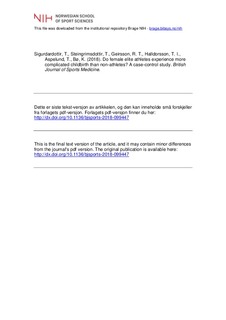| dc.contributor.author | Sigurdardottir, Torgerdur | |
| dc.contributor.author | Steingrimsdottir, Thora | |
| dc.contributor.author | Geirsson, Reynir Tomas | |
| dc.contributor.author | Halldorsson, Thorhallur Ingi | |
| dc.contributor.author | Aspelund, Thor | |
| dc.contributor.author | Bø, Kari | |
| dc.date.accessioned | 2018-11-01T13:51:26Z | |
| dc.date.available | 2018-11-01T13:51:26Z | |
| dc.date.created | 2018-09-20T13:27:34Z | |
| dc.date.issued | 2018 | |
| dc.identifier.citation | British Journal of Sports Medicine. 2018. | nb_NO |
| dc.identifier.issn | 0306-3674 | |
| dc.identifier.uri | http://hdl.handle.net/11250/2570669 | |
| dc.description | I Brage finner du siste tekst-versjon av artikkelen, og den kan inneholde ubetydelige forskjeller fra forlagets pdf-versjon. Forlagets pdf-versjon finner du på bjsm.bmj.com / In Brage you'll find the final text version of the article, and it may contain insignificant differences from the journal's pdf version. The definitive version is available at bjsm.bmj.com | nb_NO |
| dc.description.abstract | Objective: Previous studies have suggested that female athletes might be at higher risk of experiencing complications such as caesarean sections and perineal tears during labour than non-athletes. Our aim was to study delivery outcomes, including emergency caesarean section rates, length of the first and second stages of labour and severe perineal tears, in first-time pregnant elite athletes compared with non-athletes. Methods: This is a retrospective case–control study comparing birth outcomes of primiparous female elite athletes engaging in high-impact and low-impact sports compared with non-athletic controls. The athletes had prior to birth competed at a national team level or equivalent. Participant characteristics and frequency of training for at least 3 years before a first pregnancy were collected via a self-administered questionnaire. Information on delivery outcome was retrieved from the Icelandic Medical Birth Registry. Results: In total, 248 participated, 118 controls, 41 low-impact and 89 high-impact elite athletes. No significant differences were found between the groups with regard to incidence of emergency caesarean section or length of the first and second stages of labour. The incidence of third-degree to fourth-degree perineal tears was significantly higher (23.7%) among low-impact athletes than in the high-impact group (5.1%, p=0.01), but no significant differences were seen when the athletes were compared with the controls (12%; p=0.09 for low-impact and p=0.12 for high-impact athletes). Conclusion: Participation in competitive sports at the elite level was not related to adverse delivery outcome, including length of labour, the need for caesarean section during delivery and severe perineal tears. | nb_NO |
| dc.language.iso | eng | nb_NO |
| dc.subject | athlete | |
| dc.subject | female | |
| dc.subject | obstetrics | |
| dc.subject | pelvic floor | |
| dc.title | Do female elite athletes experience more complicated childbirth than non-athletes? A case–control study | nb_NO |
| dc.title.alternative | Do female elite athletes experience more complicated childbirth than non-athletes? A case–control study | nb_NO |
| dc.type | Journal article | nb_NO |
| dc.type | Peer reviewed | nb_NO |
| dc.description.version | acceptedVersion | nb_NO |
| dc.source.pagenumber | 5 | nb_NO |
| dc.source.journal | British Journal of Sports Medicine | nb_NO |
| dc.identifier.doi | 10.1136/bjsports-2018-099447 | |
| dc.identifier.cristin | 1611501 | |
| dc.description.localcode | Seksjon for idrettsmedisinske fag / Department of Sports Medicine | nb_NO |
| cristin.unitcode | 150,34,0,0 | |
| cristin.unitname | Seksjon for idrettsmedisinske fag | |
| cristin.ispublished | true | |
| cristin.fulltext | postprint | |
| cristin.qualitycode | 2 | |
